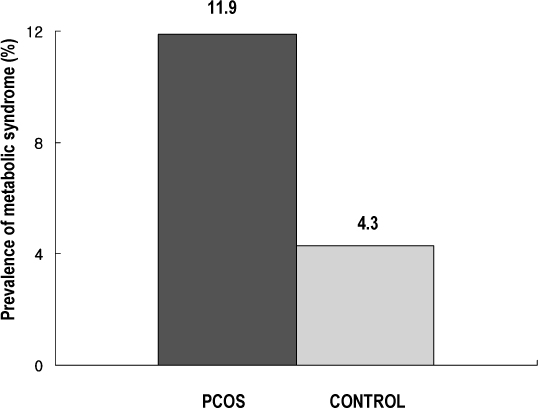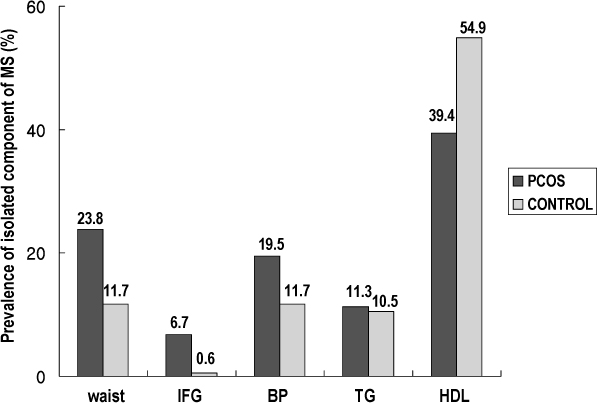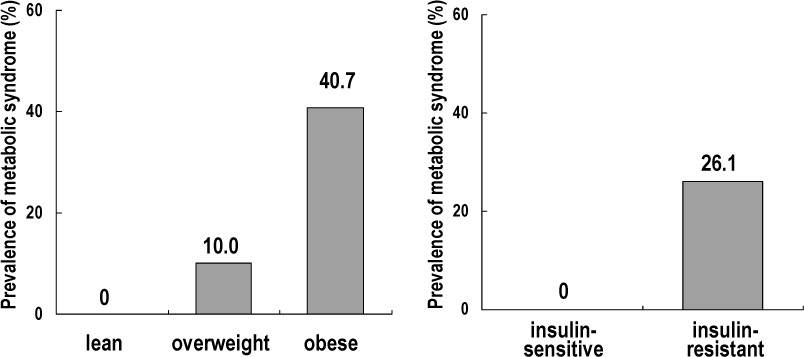J Korean Diabetes Assoc.
2006 Jul;30(4):285-291. 10.4093/jkda.2006.30.4.285.
Prevalence of Metabolic Syndrome in Young Korean Women with Polycystic Ovary Syndrome
- Affiliations
-
- 1Department of Internal Medicine, Ewha Womans University College of Medicine, Korea.
- 2Department of Obstetrics and Gynecology, Ewha Womans University College of Medicine, Korea.
- KMID: 2177600
- DOI: http://doi.org/10.4093/jkda.2006.30.4.285
Abstract
-
BACKGROUND: Polycystic ovary syndrome (PCOS) is characterized by insulin resistance and consequent hyperinsulinemia. Insulin resistance plays an important role in the development of metabolic syndrome (MS). We conducted a cross-sectional study to determine the prevalence of the MS and whether the insulin resistance or hyperandrogenemia is related to the MS in young Korean women with PCOS.
METHODS
143 women with PCOS (mean age 26+/-5 years) were studied to evaluate the prevalence of MS by modified Adult Treatment Panel III. Insulin sensitivity was evaluated by euglycemic hyperinsulinemic clamp technique.
RESULTS
The prevalence of MS in women with PCOS was 11.9%, 2.8-fold higher than age matched women in Korean urban population. The most frequent component of MS was low HDL cholesterol (39.4%), and the least frequent one was high fasting serum glucose levels (6.7%). The frequency of MS was 40.7% in obese PCOS (BMI > or = 25 kg/m2, n = 38), 10.0% in overweight PCOS (BMI 23~24.9 kg/m2, n = 13), and 0% in lean PCOS (BMI < 23 kg/m2, n = 92). The frequency of MS was 26.1% in insulin resistant PCOS (insulin mediated glucose uptake, IMGU < lowest 10th percentile of lean controls, n = 65), whereas no one had MS in insulin sensitive PCOS (IMGU > or = lowest 10th percentile of lean controls, n = 78).
CONCLUSION
MS is frequent in young women with PCOS, and obesity and insulin resistance might be essential for the development of MS in this study group.
Keyword
MeSH Terms
Figure
Cited by 1 articles
-
Relationship between flavonoids intake and metabolic syndrome in Korean women with polycystic ovary syndrome∗
Ji Soo Oh, Mi Jin Ahn, Han Chan Jung, Kim Hyesook, Oran Kwon, Hye Won Chung, Namsoo Chang
J Nutr Health. 2014;47(3):176-185. doi: 10.4163/jnh.2014.47.1.176.
Reference
-
1. Diamanti-Kandarakis E, Kouli CR, Bergiele AT, Filandra FA, Tsianateli TC, Spina GG, Zapandi ED, Bartzis MI. A survey of the polycystic ovary syndrome in the Greek island of Lesbos: hormonal and metabolic profile. J Clin Endocrinol Metab. 1999. 84:4006–4011.2. Knochenhauer ES, Key TJ, Kahsar-Miller M, Waggoner W, Boots LR, Azziz R. Prevalence of the polycystic ovary syndrome in unselected black and white women of the southeastern United States: a prospective study. J Clin Endocrinol Metab. 1998. 83:3078–3082.3. Dunaif A, Segal KR, Shelley DR, Green G, Dobrjansky A, Licholai T. Evidence for distinctive and intrinsic defects in insulin action in polycystic ovary syndrome. Diabetes. 1992. 10:1257–1266.4. Dunaif A. Insulin resistance and the polycystic ovary syndrome: mechanism and implications for pathogenesis. Endocr Rev. 1997. 18:774–800.5. Ehrmann DA, Barnes RB, Rosenfield RL, Cavaghan MK. Prevalence of impaired glucose tolerance and diabetes in women with polycystic ovary syndrome. Diabetes Care. 1999. 22:141–146.6. Legro RS, Kunselman AR, Dodson WC, Dunaif A. Prevalence and predictors of risk for type 2 diabetes mellitus and impaired glucose tolerance in polycystic ovary syndrome: a prospective, controlled study in 254 affected women. J Clin Endocrinol Metab. 1999. 84:165–169.7. Reaven GM. Insulin resistance, hyperinsulinemia, hypertriglyceridemia, and hypertension. Parallels between human disease and rodent models. Diabetes Care. 1991. 14:195–202.8. Haffner SM, D'Agostino R Jr, Festa A, Bergman RN, Mykkanen L, Karter A, Saad MF, Wagenknecht LE. Low insulin sensitivity (S(i) = 0) in diabetic and nondiabetic subjects in the insulin resistance atherosclerosis study: is it associated with components of the metabolic syndrome and nontraditional risk factors. Diabetes Care. 2003. 26:2796–2803.9. Third Report of the National Cholesterol Education Program (NCEP). Expert Panel on Detection, Evaluation, and Treatment of High Blood Cholesterol in Adults (Adult Treatment Panel III) final report. Circulation. 2002. 106:3143–3421.10. Glueck CJ, Papanna R, Wang P, Goldenberg N, Sieve-Smith L. Incidence and treatment of metabolic syndrome in newly referred women with confirmed polycystic ovarian syndrome. Metabolism. 2003. 52:908–915.11. Apridonidze T, Essah PA, Iuorno MJ, Nestler JE. Prevalence and characteristics of the metabolic syndrome in women with polycystic ovary syndrome. J Clin Endocrinol Metab. 2005. 90:1929–1935.12. Vrbikova J, Vondra K, Cibula D, Dvorakova K, Stanicka S, Sramkova D, Sindelka G, Hill M, Bendlova B, Skrha J. Metabolic syndrome in young Czech women with polycystic ovary syndrome. Hum Reprod. 2005. 20:3328–3332.13. Vural B, Caliskan E, Turkoz E, Kilic T, Demirci A. Evaluation of metabolic syndrome frequency and premature carotid atherosclerosis in young women with polycystic ovary syndrome. Hum Reprod. 2005. 20:2409–2413.14. Coviello AD, Legro RS, Dunaif A. Adolescent girls with polycystic ovary syndrome have an increased risk of the metabolic syndrome associated with increasing androgen levels independent of obesity and insulin resistance. J Clin Endocrinol Metab. 2006. 91:492–497.15. Rotterdam ESHRE/ASRAM-Sponsored PCOS Consensus Workshop Group. Revised 2003 consensus on diagnostic criteria and long-term health risks related to polycystic ovary syndrome. Fertil Steril. 2004. 81:19–25.16. WHO Western Pacific Region. IASO. IOTF. The Asia-Pacific Perspective: Redefining Obesity and Its Treatment. 2000. Sydney, Australia: Health Communications Australia Pty Limit.17. The Asia-Pacific perspective: Redefining obesity and its treatment [article online]. 2000. Available from http://www.diabetes.com.au/downloads/obesity-report.pdf.18. DeFronzo RA, Tobin JD, Andres R. Glucose clamp technique: a method for quantifying insulin secretion and resistance. Am J Physiol. 1979. 237:E214–E223.19. Oh JY, Hong YS, Sung YA, Barrett-Connor E. Prevalence and factor analysis of metabolic syndrome in an urban Korean population. Diabetes Care. 2004. 27:2027–2032.20. Legro RS, Urbanek M, Kunselman AR, Leiby BE, Dunaif A. Self-selected women with polycystic ovary syndrome are reproductively and metabolically abnormal and undertreated. Fertil Steril. 2002. 78:51–57.21. Nofer JR, van der Giet M, Tolle M, Wolinska I, von Wnuck Lipinski K, Baba HA, Tietge UJ, Godecke A, Ishii I, Kleuser B, Schafers M, Fobker M, Zidek W, Assmann G, Chun J, Levkau B. HDL induces NO-dependent vasorelaxation via the lysophospholipid receptor S1P3. J Clin Invest. 2004. 113:569–581.22. Pierpoint T, McKeigue PM, Isaacs AJ, Wild SH, Jacobs HS. Mortality of women with polycystic ovary syndrome at long-term follow-up. J Clin Epidemiol. 1998. 51:581–586.23. Wild S, Pierpoint T, McKeigue P, Jacobs H. Cardiovascular disease in women with polycystic ovary syndrome at long-term follow-up: a retrospective cohort study. Clin Endocrinol. 2000. 52:595–600.24. Solomon CG, Hu FB, Dunaif A, Rich-Edwards JE, Stampfer MJ, Willett WC, Speizer FE, Manson JE. Menstrual cycle irregularity and risk for future cardiovascular disease. J Clin Endocrinol Metab. 2002. 87:2013–2017.25. Korhonen S, Hippelainen M, Vanhala M, Heinonen S, Niskanen L. The androgenic sex hormone profile is an essential feature of metabolic syndrome in premenopausal women: a controlled community-based study. Fertil Steril. 2003. 79:1327–1334.26. Golden SH, Ding J, Szklo M, Schmidt MI, Duncan BB, Dobs A. Glucose and insulin components of the metabolic syndrome are associated with hyperandrogenism in postmenopausal women: the atherosclerosis risk in communities study. Am J Epidemiol. 2004. 160:540–548.27. Dieudonne MN, Pecquery R, Boumediene A, Leneveu MC, Giudicelli Y. Androgen receptors in human preadipocytes and adipocytes: regional specificities and regulation by sex steroids. Am J Physiol. 1998. 274:C1645–C1652.28. Vermeulen A, Verdonck L, Kaufman JM. A critical evaluation of simple methods for the estimation of free testosterone in serum. J Clin Endocrinol Metab. 1999. 84:3666–3672.
- Full Text Links
- Actions
-
Cited
- CITED
-
- Close
- Share
- Similar articles
-
- Polycystic Ovary Syndrome in Korean Women: Clinical Characteristics and Diagnostic Criteria
- Medical diagnosis and treatment of polycystic ovary syndrome
- Epidemiology and Diagnostic Criteria of Polycystic Ovary Syndrome
- Recent Treatment Strategies for Polycystic Ovary Syndrome
- Studies on Fibrinolytic System Behavior in Women with Polycystic Ovary Syndrome




